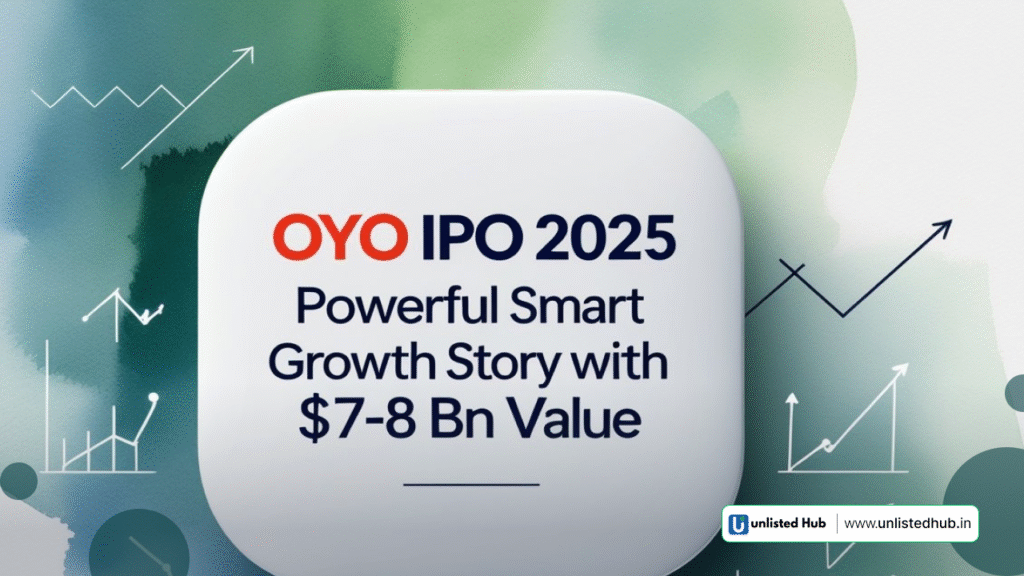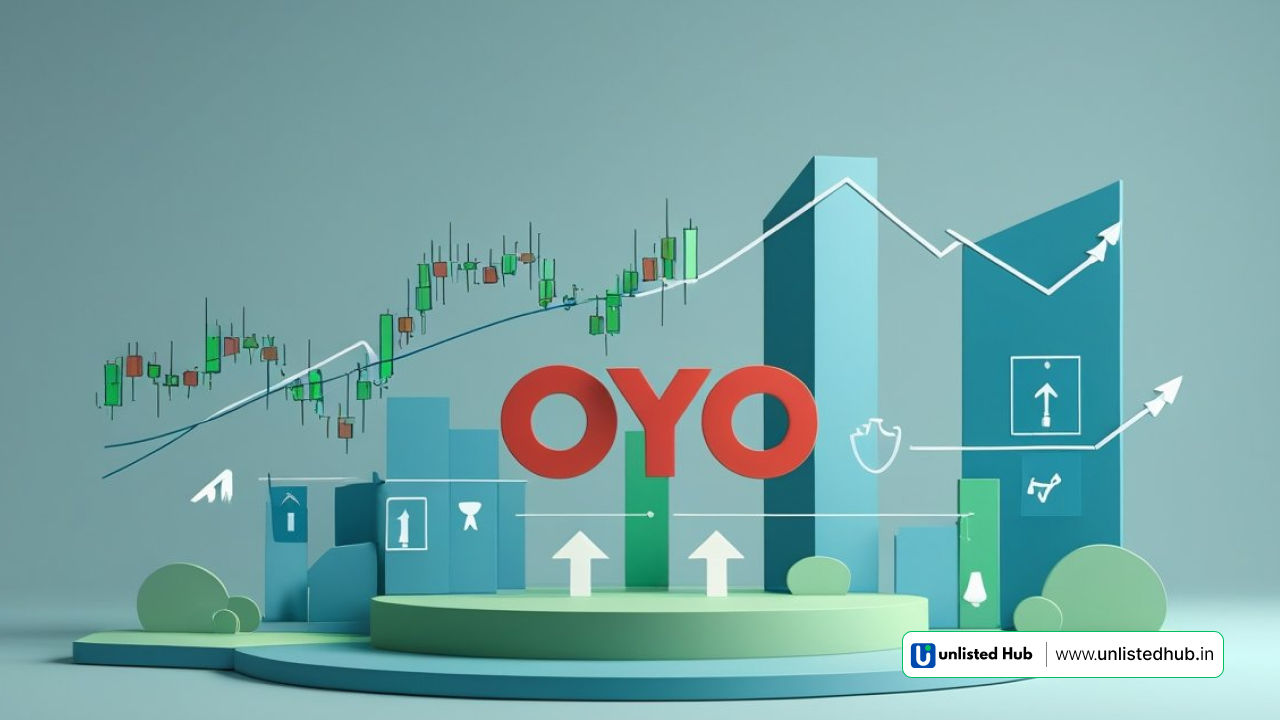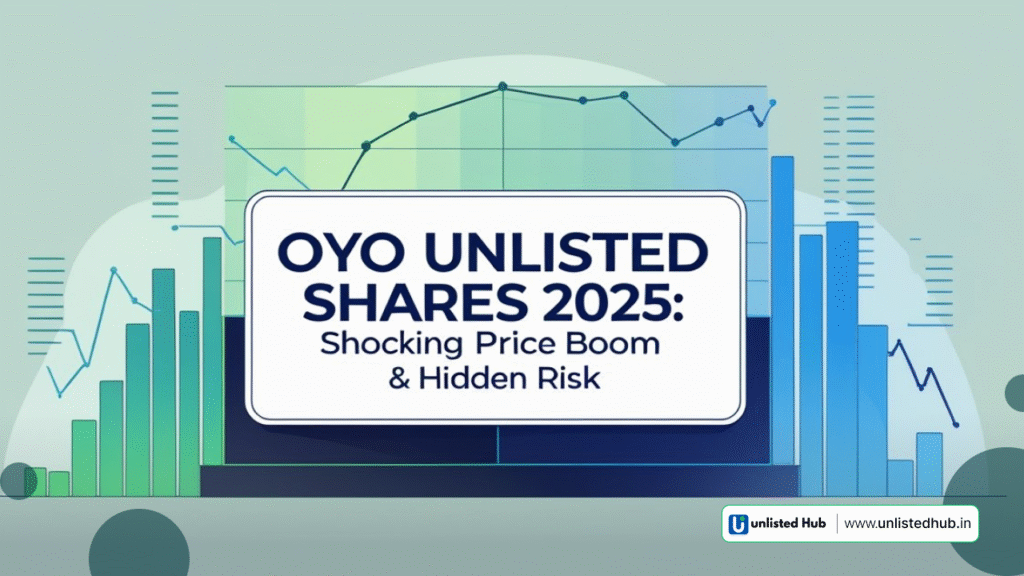SECTION A: Why OYO IPO Keeps Slipping—SoftBank’s Resistance Explained
The OYO IPO has been in the spotlight for a long time, but it still hasn’t reached the market. Every time it looks close, another roadblock comes up. One of the biggest reasons is the resistance from SoftBank, OYO’s largest shareholder. To understand this better, let’s break it down step by step.
~ Quick Snapshot in a Table
| Factor | What It Means |
| SoftBank’s Resistance | Concerned about valuation and timing, pushing back against quick listing |
| Market Conditions | Volatile markets make investors more cautious |
| Valuation Gap | Difference between what OYO wants and what investors believe it is worth |
| Business Turnaround | Profits are improving, but investors want to see stable long-term numbers |
| Past Attempts | OYO has delayed its IPO multiple times already |
~ Why SoftBank Is Holding Back
-> SoftBank owns a major chunk of OYO, which means its approval is critical for the IPO.
-> They believe the company’s current valuation expectations may not match market reality.
-> Their resistance is one of the biggest reasons behind the repeated OYO IPO delay SoftBank issue.
~ Other Reasons Behind the Delay
-> Market volatility: Global and Indian markets have seen big ups and downs, which makes timing risky.
-> Valuation differences: Reports suggest OYO is targeting higher numbers, while investors prefer a conservative range.
-> Track record: OYO’s earlier financial struggles make many cautious even though it recently posted profits.
~ What Investors Are Watching
-> Sustainable profits: A one-time profit isn’t enough; consistent performance matters.
-> Debt pressure: Investors know SoftBank has loan exposure, so they want clarity on repayments.
-> Growth strategy: OYO’s push in global markets and QSR (kitchen and food) services will play a role in convincing investors.
~ Key Takeaway for Readers
When users hear about the delays, it’s not just about paperwork—it’s about deeper trust issues between OYO, its main investor SoftBank, and the market.
-> OYO is showing signs of recovery.
-> SoftBank wants the right timing and a valuation it trusts.
-> Investors will wait to see both sides align before the IPO finally takes off.
SECTION B: How OYO’s FY25 Profit Turnaround Boosts IPO Prospects
The OYO IPO story has taken a new turn after the company posted profits in FY25. For years, OYO struggled with heavy losses, but now its financial health is looking stronger. This shift is changing how investors, analysts, and even its largest backer view the company.
~ Quick Snapshot in a Table
| Factor | What It Means for IPO Prospects |
| FY25 Profit | OYO posted profits after years of losses, building fresh investor trust |
| Investor Sentiment | Positive shift as the market values profitability over just growth |
| Valuation Potential | Stronger earnings give support to higher valuation expectations |
| Business Stability | Signals that OYO’s turnaround may be long-term, not a one-time event |
| OYO FY25 profit IPO impact | Directly boosts chances of approval from investors and regulators |
~ Why This Profit Matters
-> Profits in FY25 prove that OYO’s cost-cutting and efficiency measures are working.
-> It reduces doubts about sustainability that earlier held back investor confidence.
-> The profit turnaround has created a strong buzz in the market, improving listing prospects.
~ How It Changes Investor Sentiment
-> Trust is improving: Investors are more likely to consider the IPO seriously.
-> Stability over hype: Profitability matters more than growth promises now.
-> Global investors: International funds often avoid loss-making companies, so profit status makes OYO more attractive.
~ Impact on Valuation
-> Profitable numbers can justify OYO aiming for valuations between $7–$8 billion.
-> Analysts say the improved earnings give a stronger case during discussions with banks.
-> With profitability, OYO may not need to compromise too much on its expected value.
~ What Users Should Understand
When we hear about OYO’s turnaround, it’s not just a number in a report. It’s about:
-> Confidence for the market: A profitable company is easier to trust.
-> Better IPO chances: A healthy balance sheet makes regulators and investors more comfortable.
-> Future path: If OYO keeps up this performance, the IPO could finally happen with strong demand.
SECTION C: Banks Engaged: When Will OYO Finally File DRHP?
The OYO IPO has gone through multiple delays, but now attention is shifting to when the company will finally file its DRHP (Draft Red Herring Prospectus). With banks engaged and discussions moving forward, investors are curious about the exact timeline. Understanding this step is important because the DRHP is the official document that sets the stage for the IPO process.
~ Quick Snapshot in a Table
| Factor | What It Means for the IPO Process |
| Bank Engagement | Investment banks guide valuation, paperwork, and market strategy |
| DRHP Filing | A mandatory step before IPO approval from SEBI |
| OYO file DRHP timeline | Key detail investors are tracking to know when the IPO may launch |
| Valuation Discussions | Banks and OYO align on the expected $7–$8 billion range |
| Investor Expectations | Filing DRHP signals OYO is serious about moving forward |
~ Why DRHP Filing Matters
-> Filing the DRHP is the green light that shows regulators and investors the IPO plan.
-> It includes details like financials, risks, and how much money OYO plans to raise.
-> Without it, the IPO cannot move forward, making this step critical.
~ Role of Banks in the Process
-> Advisors: Banks help OYO decide the right valuation and timing.
-> Documentation: They prepare the DRHP draft with financial and legal details.
-> Market Strategy: Banks ensure the offering appeals to both domestic and global investors.
~ Why Delays Are Happening
-> Valuation debates: OYO and investors sometimes disagree on worth.
-> Market volatility: Banks are cautious about launching in uncertain markets.
-> Shareholder pushback: Major investors like SoftBank want the right timing.
~ What Investors Should Watch
-> Engagement progress: Which banks are on board and leading the process.
-> Draft filing date: The moment OYO files, the process becomes official.
-> Regulatory review: After filing, SEBI reviews and may request clarifications.
~ Key Points for Readers
-> The DRHP is like the roadmap of the IPO.
-> Banks play a central role in making sure everything is in place.
-> Investors are waiting for this filing to confirm OYO’s seriousness about the IPO.
SECTION D: OYO IPO Valuation Range: $5B–$7B or $7B–$8B?
The OYO IPO has created debate in the market because of its wide valuation expectations. Some reports point to a$ 5 –$ 7 billion range, while others suggest OYO is aiming indeed advanced at$ 7 –$ 8 billion. This gap raises questions about what is realistic and what investors are truly ready to pay.
~ Quick Snapshot in a Table
| Factor | What It Means for OYO’s Valuation |
| $5B–$7B Range | Seen as conservative, safer, and more acceptable to cautious investors |
| $7B–$8B Range | Reflects OYO’s ambition, based on recent profits and future growth plans |
| Investor Concerns | Higher valuation may look risky given OYO’s past financial struggles |
| Market Sentiment | Global market volatility makes high valuation harder to justify |
| OYO IPO valuation range | Shows the difference between investor expectations and company targets |
~ Why the Valuation Debate Exists
-> Investors look at OYO’s profit turnaround but remain cautious about long-term stability.
-> The company wants to showcase strong growth potential in new markets.
-> Differences arise because banks and investors often take a more conservative approach.
~ What a Lower Valuation ($5B–$7B) Suggests
-> More acceptable: Safer entry point for cautious investors.
-> Easier approval: Regulators and banks may favor realistic pricing.
-> Faster listing: A moderate valuation could avoid long delays.
~ What a Higher Valuation ($7B–$8B) Suggests
-> Ambition: OYO wants to highlight its improved profits and global presence.
-> Stronger returns: Existing shareholders like SoftBank push for higher numbers.
-> Risk factor: Could face pushback if the market doesn’t see sustained earnings.
~ What Readers Should Note
When people hear about OYO’s valuation debate, it’s really about balance:
-> Conservative vs ambitious pricing.
-> Investor trust vs company expectations.
-> Market conditions vs growth potential.
Both ranges are possible, but the final decision will depend on how well OYO convinces investors that its recent recovery is not temporary.
SECTION E: Market Volatility & Nifty Drop: Is the Timing Right for OYO?
The OYO IPO has been delayed multiple times, and one major factor behind it is the uncertain stock market. With the Nifty index facing ups and downs, investors and companies alike are being extra cautious about when to enter the market. Timing is everything for an IPO, and OYO knows it has to pick the right moment.
~ Quick Snapshot in a Table
| Factor | What It Means for OYO IPO |
| Nifty Drop | Lower investor confidence, risk of weak IPO response |
| Market Volatility | Hard to predict returns, increases listing risks |
| Investor Sentiment | Shaky markets make investors less likely to invest in new listings |
| Valuation Pressure | Difficult to justify higher valuation in a falling market |
| OYO IPO timing market volatility | Decides whether OYO will delay or move forward with listing plans |
~ Why Market Conditions Matter
-> IPOs need stable markets to attract strong demand.
-> If indexes like Nifty are falling, investors become risk-averse.
-> For OYO, poor timing could mean undervaluation or a weak listing day response.
~ Challenges in Choosing the Right Time
-> Global uncertainty: Economic slowdowns and global market jitters spill into India.
-> Investor behavior: In volatile markets, people prefer safe stocks over new, untested IPOs.
-> Competition: Other big IPOs waiting to list can also affect investor appetite for OYO.
~ Possible Strategies OYO Could Use
-> Wait for stability: Delay until Nifty shows positive momentum again.
-> Adjust valuation: Be flexible with pricing to match market sentiment.
-> Strong communication: Highlight profit turnaround and cost discipline to build trust.
~ What Readers Should Understand
When the market is volatile, IPOs are risky not just for companies but for investors too. For OYO, the decision to go public depends on:
-> Confidence in Nifty’s recovery.
-> Willingness to adjust valuation.
-> Ability to show consistent profits.
A stable environment is key if OYO wants its IPO to succeed and attract strong investor interest.
SECTIN F: SoftBank Loan Pressure: Is That Driving OYO’s Listing Plans?
The OYO IPO has been delayed multiple times, but one factor that keeps coming up is the financial pressure linked to SoftBank. As OYO’s largest investor, SoftBank has extended loans and support to the company. Many believe these commitments are pushing OYO closer to listing sooner rather than later.
~ Quick Snapshot in a Table
| Factor | What It Means for OYO IPO Plans |
| SoftBank Loan Support | Financial backing keeps OYO afloat but adds repayment pressure |
| Loan Repayment Needs | IPO seen as a way to clear part of debt |
| Investor Concerns | Market wants clarity on how loans impact future stability |
| Valuation Decisions | Pressure may affect how aggressively OYO sets its IPO valuation |
| OYO IPO loan pressure | A critical driver influencing timing and execution of the listing |
~ Why the Loan Pressure Matters
-> SoftBank has invested heavily in OYO, both in equity and financial support.
-> These loans don’t just add capital—they create repayment obligations that OYO must handle.
-> An IPO gives OYO access to fresh capital, which can help ease repayment stress.
~ How It Shapes IPO Timing
-> Faster listing push: The need to manage financial obligations can speed up the IPO process.
-> Valuation trade-offs: OYO may have to balance between its desired high valuation and SoftBank’s urgency.
-> Banker involvement: Discussions with banks show how loan-linked timing plays a role in IPO planning.
~ Concerns from Investors
-> Debt clarity: Investors want full transparency on how much debt OYO carries from SoftBank.
-> Use of IPO funds: They expect clear allocation—whether proceeds will fund growth or repay loans.
-> Sustainability: Loan pressure raises questions about whether the IPO is growth-driven or debt-driven.
~ What Users Should Understand
-> OYO’s listing isn’t just about market entry—it’s tied to financial realities.
-> SoftBank’s loan pressure is shaping when and how the IPO happens.
-> For investors, this means keeping an eye not just on profits but also on how OYO manages its debt.
SECTION G: Global Expansion + QSR Strategy: How OYO Is Shaping Growth
The OYO IPO is not just about financial numbers. A big part of the story is how OYO is expanding globally and building new revenue streams like its Quick Service Restaurant (QSR) strategy. Both moves show that the company is preparing for long-term growth, not just a short-term listing.
~ Quick Snapshot in a Table
| Factor | What It Means for OYO’s Growth |
| Global Expansion | Presence in international markets to diversify income |
| QSR Strategy | Adding food and kitchen services to strengthen revenue model |
| Brand Value | Expanding beyond hotels into hospitality ecosystem |
| Investor Confidence | Wider business scope attracts more global investors |
| OYO global expansion QSR | Directly linked to building long-term growth prospects |
~ Global Expansion Moves
-> OYO is actively entering new international markets, especially in Southeast Asia, Europe, and the US.
-> The aim is to reduce dependency on the Indian market and create multiple growth engines.
-> By doing this, OYO positions itself as a global hospitality player, not just a local startup.
~ QSR Strategy Explained
-> The company is exploring food services by setting up kitchens and quick service restaurants.
-> QSR offers an additional revenue stream beyond room bookings.
-> This move helps OYO serve both hotel guests and walk-in customers, expanding its ecosystem.
~ Why Investors Care
-> Diversified business: More than hotels, OYO now has multiple revenue sources.
-> Reduced risks: Dependence on one market decreases, making it less vulnerable.
-> Higher valuation chances: A stronger, broader business model supports a higher listing price.
~ Impact on Growth and IPO
-> Global presence and QSR initiatives make OYO look future-ready.
-> Investors see this as proof that OYO is not relying on one business line for success.
-> A diversified model supports stronger confidence, helping the IPO case when it finally hits the market.
~ What Users Should Know
When you hear about OYO’s global push and QSR plans, it means:
-> OYO is building a complete hospitality ecosystem.
-> These strategies show seriousness about long-term sustainability.
-> They directly improve how strong the IPO could be once launched.
SECTION H: What’s Changed in OYO’s Third IPO Attempt Versus Earlier Tries?
The OYO IPO has been attempted more than once, and each time it faced setbacks. Now, in its third try, things look different. The company has made changes in strategy, numbers, and focus. This is what makes investors and the market more attentive to the latest attempt.
~ Quick Snapshot in a Table
| Factor | Earlier Attempts | Third Attempt Now |
| Financial Performance | Heavy losses and unstable earnings | Profitable in FY25, stronger balance sheet |
| Investor Confidence | Mixed, with doubts on sustainability | Better trust due to profits and cost control |
| Valuation Goals | Higher, often unrealistic for market conditions | More balanced, aligned with $7–$8 billion |
| Market Timing | Faced weak or volatile market conditions | Chosen after showing recovery and stability |
| OYO third IPO attempt differences | Lack of clarity in past filings | Focused communication and cleaner positioning |
~ Why This Attempt Looks Different
-> Profits in FY25 have changed the narrative from survival to growth.
-> Cost-cutting measures have reduced risks and improved efficiency.
-> The company is aiming for realistic valuations compared to earlier times.
~ How Investors See the Change
-> Stronger fundamentals: Profits show the business can sustain itself.
-> Cleaner books: Financial restructuring makes OYO appear more reliable.
-> Better story: Instead of only talking about growth, OYO now shows results.
~ Key Shifts in Strategy
-> Focusing on core hospitality rather than spreading into too many segments.
-> Strengthening global operations while avoiding unnecessary expansions.
-> Showing steady revenue growth instead of chasing aggressive scale.
~ What Users Should Understand
-> The third attempt is different because the company is finally showing results.
-> Investors are more open when they see profitability and stable growth.
By adjusting goals and focusing on fundamentals, OYO’s latest IPO plan has a higher chance of moving forward.
FREQUENTLY ASKED QUESTIONS:
Other Investors Are Exploring
OYO IPO || OYO IPO delay SoftBank || OYO FY25 profit IPO impact || OYO third IPO attempt differences || OYO IPO valuation || OYO third IPO attempt || OYO FY25 profit || OYO IPO timing || OYO file DRHP || OYO listing timeline || OYO profitability FY25 || OYO global expansion || OYO Motel 6 acquisition || OYO IPO 2026 || OYO governance IPO || OYO investor confidence || OYO IPO market sentiment || OYO debt repayment IPO || OYO IPO banking discussions || OYO valuation $6-7 billion || OYO IPO readiness || OYO IPO financial turnaround || SoftBank resistance || OYO profit turnaround || OYO balance sheet || OYO loan pressure || Market conditions IPO || Financial restructuring OYO || Investor sentiment OYO IPO || OYO QSR strategy || OYO Shares || OYO Share || OYO Share Price || OYO IPO Date || OYO IPO Date 2025 || OYO Share Price Today
| Financial Research Analyst





